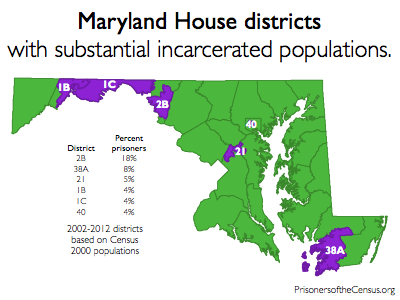New 50 state guide released: How the Census Bureau's prison miscount harms democracy, with info on prison residence law and the status of reform efforts.
by Peter Wagner,
March 22, 2010
The 2010 Census will be counting more than 2 million incarcerated people in the wrong place. The laws of most states say that a prison cell is a not a residence, but the Census Bureau assigns incarcerated people to the prison location, not their home addresses. When state and local governments use this data to draw legislative districts, they unconstitutionally enhance the weight of a vote cast in districts that contain prisons and dilute those votes cast in every other district.
Our new 50 state guide, Fixing prison-based gerrymandering after the 2010 Census, introduces the problem, the solutions, and provides state-by-state information on how the prison miscount harms state and local democracy, how each state defines residence for incarcerated people, and the status of reform efforts.
Good government group supports Schneiderman/Jeffries bill more accurately aligning state legislative Representatives with their constituents
by Peter Wagner,
March 18, 2010
The New York-based good government group Citizens Union issued this press release announcing its support for the Schneiderman/Jeffries to bill more accurately aligning state legislative representatives with their constituents.
One of the representatives of a district that could lose population if the bill were passed said he didn't see a problem with it.
by Peter Wagner,
March 14, 2010
John Hill of the Providence Journal reports:
A group of Providence legislators have introduced bills that would change how the state counts inmates at the Adult Correctional Institutions, allocating them toward the towns they lived in before sentencing rather than as residents of Cranston, the home of the state’s prison complex.
“It’s all about fairness,” said Rep. Joseph S. Almeida, D-Providence, primary sponsor of the house version of the plan. “These folks come from districts around the state and will be returning to them upon release.”
Continue reading →
by Peter Wagner,
March 13, 2010

Neal Peirce has this column in Nation Cities Weekly published by the National League of Cities: How the Census Counts Prisoners: Significant Political Stakes [PDF, page 2].
by Peter Wagner,
March 12, 2010
Bruce Reilly has this report on Tuesday’s hearing in Rhode Island to end prison-based gerrymandering.
New report identifies harm of prison-based gerrymandering in Minnesota.
March 9, 2010
The federal Census counts incarcerated people as if they resided where the prison is located, and that creates big problems for democracy in Minnesota, charges a new report by the non-profit Prison Policy Initiative.
American democracy relies on Census counts to apportion political power on the basis of equal population. By Minnesota law, prisoners can’t vote and remain residents of their home communities. “By relying on Census Bureau counts of prison populations to pad legislative districts with prisons, Minnesota is inflating the votes of residents who live near prisons at the expense of every other resident,” said report author Aleks Kajstura.
“Every decade we redraw our districts. The state uses Census data to redraw its own districts. Using prisons to pad the populations of a small number of districts dilutes the votes of everyone else,” said State Senator Linda Higgins – DFL-Minneapolis. Senator Higgins and Representative Champion are developing legislation to change the way Minnesota uses census data in redistricting.
Continue reading →
by Peter Wagner,
March 9, 2010
The Census Project Blog has posted my guest blog post: Prison Populations a Big Issue for Census. Check it out.
Recent media coverage reveals a misconception about basic principles of our electoral system. The Census Bureau does not have a “new policy” regarding populations used in redistricting.
by Aleks Kajstura,
March 8, 2010
Recent media coverage makes it clear that there is a misconception about basic principles of our electoral system. Many people are claiming that the Census Bureau has changed some policy and is now allowing states to exclude certain populations in the redistricting process.
Actually, the Census Bureau has no authority over districting. The Census Bureau does provide data that states can use in their individual redistricting processes. States use this data because it is easily accessible and often the only or best data available. States were never required to use this data. (Next week I will blog about a court case that expressly prohibited using Census data where using the data would have lead to unequal districts.)
The Census Bureau recently announced that it will publish group quarters population data in May 2011 (prisons are one kind of group quarters). If they wish, the states can adjust their populations, taking into consideration the location and population of prisons, when redistricting. The Bureau is simply making an existing process easier. A few states have already required their counties to make this exact adjustment in their populations when redistricting, and many more counties made such adjustments on their own.
The Census Bureau was simply responding to a need that was already there. The Census Bureau has no “new policy” regarding populations used for redistricting; that choice is, and always has been, reserved by each state and local goverment.
New report and resources on prison-based gerrymandering in Maryland
by Peter Wagner,
March 8, 2010
 Avi Cummings and I have finished Importing Constituents: Incarcerated People and Political Clout in Maryland, our district-by-district analysis of how crediting Baltimore City’s incarcerated residents to remote districts distorts democracy and dilutes the votes of all voters in all other districts.
Avi Cummings and I have finished Importing Constituents: Incarcerated People and Political Clout in Maryland, our district-by-district analysis of how crediting Baltimore City’s incarcerated residents to remote districts distorts democracy and dilutes the votes of all voters in all other districts.
We’ve also released two fact sheets:
and created a new page for the Maryland campaign.

 Avi Cummings and I have finished
Avi Cummings and I have finished 


